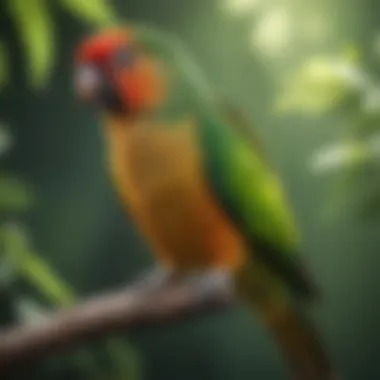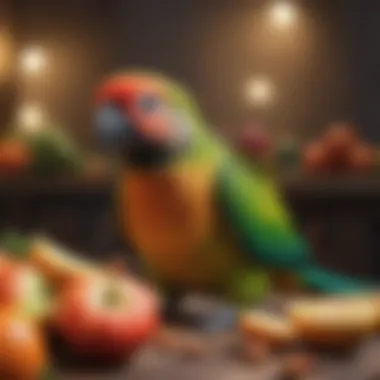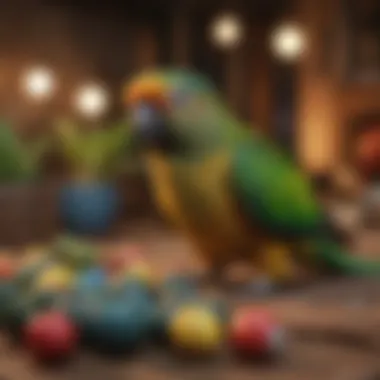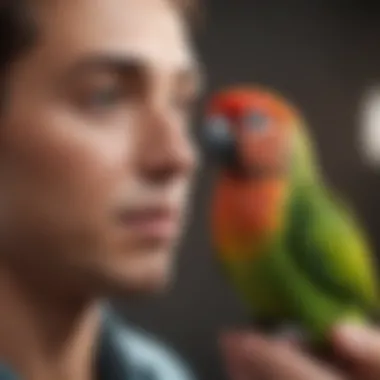The Ultimate Guide to Caring for Green Cheek Conures


Intro
Green cheek conures have become one of the most sought-after pet birds, captivating the hearts of avian enthusiasts with their vibrant colors and engaging personalities. Known for their playful nature and social behavior, these birds demand considerable attention and care. This guide aims to unravel the complexities associated with their maintenance, feeding, and overall well-being, providing pet bird owners with a toolkit for ensuring a happy and healthy environment for their feathery companions.
Care Tips
Taking care of a green cheek conure involves establishing daily routines and appropriately preparing their living space. Here are crucial aspects to consider:
Daily Care Routines
Daily care is vital for the well-being of green cheek conures. This usually involves a few key activities:
- Morning Routine: Uncover the cage and give them fresh water and food. Allow them some time for free flight.
- Social Interaction: Spend quality time with the birds through gentle communication, handling, and play.
- Evening Tasks: Store away perishable food and cover the cage at night, creating a dark environment for rest.
Cage Setup and Maintenance
A well-organized cage is paramount for green cheek conures.
- Size: A cage measuring a minimum of 24 x 24 x 36 inches is Ideally compact but allows sufficient room for movement.
- Accessories: Include perches of varying diameters, toys for engagement, and food and water bowls.
- Location: Place the cage in a lively area to stimulate social interaction but ensure it is draft-free.
Hygiene and Cleaning Practices
Regular cleaning prevents disease and promotes well-being. Take the account the following:
- Daily: Remove droppings, and replace old food and water.
- Weekly: Clean toys and perches with safe, bird-friendly cleaners or vinegar solution.
- Monthly: Wash the cage and change the bedding.
Seasonal Care Adjustments
Green cheek conures can feel seasonal changes. Adapt accordingly:
- Winter: Provide additional warmth, such as heat lamps, if temperatures drop.
- Summer: Ensure adequate air ventilation and hydration as birds may become dehydrated.
Behavioral Insights
Understanding a green cheek conure's behavior enhances your ability to respond to its needs effectively.
Understanding Bird Body Language
Birds communicate through a variety of body signals, including:
- Posture: A relaxed stance may mean comfort, while puffed feathers can indicate stress.
- Wing Flapping: This could mean excitement or an invitation to interact.
Common Behavioral Issues and Solutions
Being proactive helps in emotional and physical health. Here are suitable resolutions:
- Biting: Assess if the bird feels threatened or overly hormonal and adjust interactions accordingly.
- Feather plucking: This may signal boredom; increase avian engagement and provide stimulating toys.
Positive Reinforcement Techniques
Using positive reinforcement strengthens the bond:
- Reward with treats to encourage desired behaviors.
- Use a calm voice to speak while teaching new tricks.
Social Interaction Needs
Green cheek conures thrive in interactive environments:
- Schedule frequent sessions of play and exploration.
- Consider companionship if owning only one bird, as solitude could lead to depression.
Nutrition Guides
A balanced diet is paramount.
Essential Diet Components
The foundation of a proper diet includes:
- Pellets: Commercially available formulations specifically made for conures ensure essential nutrients.
- Fresh Fruits and Vegetables: Remove wilted or spoiled produce daily for health.
- Nuts: Offer small quantities occasionally as a treat.
Safe and Toxic Foods
Certain foods can be harmful; familiarize yourself with:
- Safe options: Apples, carrots, and leafy greens.
- Toxic selections: Avocado, chocolate, and caffeine-containing substances.


Supplements and Treats
Occasional treats can be beneficial:
- Calcium Blocks: Aid in bone health.
- Seed Mixes: To prevent boredom but should not form the base diet.
Feeding Strategies for Different Species
Different breeds can have adjusted feeding strategies. Consider consulting avian veterinarians for specific diets as well.
Wellness and Health
Focus on general and active well-being.
Routine Health Checkups
Regular vet visits are essential for identifying health issues before they escalate.
Identifying Symptoms of Illness
Monitor for signs, such as:
- Changes in singing or vocalizations.
- Abnormal stool or lethargic demeanor.
Preventative Care and Vaccinations
Taking preventative measures helps maintain long-term health.
Mental and Emotional Well-being
A stimulating environment influences the mood significantly. Engage in chatter, offer varied activities, and ensure a safe space for emotional stability.
Enriching Activities
A balanced life requires stimulation.
Toys and Playtime Ideas
Invest in stimulating toys to occupy time and prevent maladaptive behaviors:
- Chewing toys to promote healthy beaks.
- Interactive puzzles for cognitive development.
Training and Tricks
Using small rewards, you can train green cheek conures to do enjoyable actions. Begin with basic commands or fun tricks and keep sessions brief.
Outdoor Activities and Interaction
When suitable weather allows:
- Supervised outings expose the bird to fresh air and various stimuli while maintaining safety.
DIY Projects for Mental Stimulation
Homemade toys from safe materials or constructing unique perches cultivate creativity.
“A engaged pet leads to happier wellbeing, impacting the owner positively as well.”
Prelude to Green Cheek Conures
Green cheek conures have gained substantial popularity among pet bird enthusiasts. These small, vibrant birds posses a charm and charisma that make them a desirable companion. Understanding their origins and physical traits is crucial for aspiring bird owners. This foundational knowledge helps ensure proper care and an enhanced bond with the bird.
Origins and Natural Habitats
Green cheek conures are native to various regions in South America. Particularly, they are found in eastern Bolivia, the northern parts of Argentina, and the western area of Brazil. These birds inhabit forests, woodlands, and even areas close to human settlements. Understanding their natural habitat informs owners about the type of environment and space these birds thrive in when kept as pets.
In the wild, green cheek conures live in flocks. They socialize and engage with one another, which plays a significant role in their behaviors. Recognizing their roots helps owners appreciate their social dynamics. Additionally, it emphasizes the importance of providing interaction and stimulation when kept in captivity.
Physical Characteristics
Green cheek conures are recognizable for their striking plumage and distinct features. They typically measure between 9 to 10 inches in length. Their bodies are stocky, and they possess a relatively short tail.
The birds are known for their broad range of colors, which vary among individuals. Common hues include dark green, olive, and a pop of red or yellow on their underparts. Their faces are generally vivid and have a eye-catching appearance.
- Beaks: They have strong, slightly curved beaks, suitable for cracking seeds and nuts.
- Feet: Their feet are zygodactyl, which means two toes point forward and two backward, aiding in climbing and grasping.


Acknowledging these physical traits can assist in determining their health and well-being. Any changes in appearance could signal underlying health issues, so regular checks should be a part of bird care routines.
Understanding a green cheek conure’s origins and physical characteristics establishes a foundation for responsible ownership.
Behavioral Insights
Understanding the behavioral insights of green cheek conures is crucial for building meaningful relationships with these charming birds. Their social nature and playful demeanor create dynamic interactions that can be both rewarding and complex. Grasping their behavior helps conure owners provide a supportive environment where their birds can thrive, and it allows for better communication between the bird and the owner.
Social Interaction and Bonding
Green cheek conures are inherently social animals. They exist in flocks in the wild and seek companionship, whether with birds or humans. This social behavior plays a vital role in their overall well-being. Building a strong bond between the conure and its owner enhances trust and reduces stress for the bird.
Ways to encourage social interaction include:
- Spending quality time with the bird daily, engaging in activities like gentle talking.
- Offering toys that stimulate interaction, like foraging items.
- Allowing the bird out of the cage to explore environments with human company.
Establishing bond requires patience but is rewarding. It can be as simple as letting the bird perch on one’s shoulder. Over time, these interactions strengthen the connection and can render the bird more responsive to commands and affection.
Activity Levels and Playfulness
Activity levels in green cheek conures vary, but they generally exhibit high energy and a need to play. Frequent stimulation through play is essential; without it, they can become bored or anxious. Their playful nature allows them to adapt well to new challenges, making play an excellent opportunity for training and bonding.
Activities that suit their playful nature include:
- Safe chew toys to alleviate dental wear and entertain
- Simple, engaging games like fetch or chase with soft objects
- Setting up obstacle courses to encourage physical activity
Incorporating varied activities addresses their need for mental enrichment and minimizes behavioral issues driven by boredom. Owners should remain attentive to their birds’ energy levels and alter the environment to keep it interesting.
Vocalization Patterns
Vocalizations are a key part of communication for green cheek conures. Their sounds convey a wide range of emotions and desires, serving as an essential hallmark of their behavioral patterns. Owners must pay attention to these vocal cues to understand when a bird is content, anxious, or in distress.
Additinally, common vocalizations can include:
- Whistles to signal happiness or playfulness.
- Squawking when yearning attention or sometimes as a protest.
- Mimicking sounds from their environment.
Understanding these vocalization patterns not only fosters clearer communication but also enriches the relationship between the conure and its owner. Recognizing what each sound signifies will help address behavioral needs and ensure that the conure feels heard and cared for.
Key insight: Regular observation of behavior can pinpoint underlying health concerns early on. Distressed birds might change their vocal patterns, which requires immediate owner attention.
Optimizing your bonding experience should be a priority for every conure owner. Building interactions based on social behavior, playfulness, and careful listening to vocalizations can yield a fulfilling companionship.
Nutrition and Diet
Understanding the correct nutrition and diet for green cheek conures is vital. A well-balanced diet ensures a vibrant pet and can prevent health problems that emerge from improper feeding. Pet bird owners seeking to optimize their conure's dietary needs benefit greatly from knowledge about suitable food choices. For green cheek conures, the right diet contributes not only to physical health but also to emotional well-being.
Balanced Diet Essentials
A balanced diet for green cheek conures involves a variety of food components. Seeds should a part but not the only element. A conure's diet may benefit from a mix of the following:
- Pelleted food: This provides essential nutrients.
- Fresh fruits: Apples, carrots, and pears can appeal.
- Vegetables: Leafy greens, broccoli, and bell peppers enhance nutrition eventually.
- Grains: Whole grains offer important carbs.
It's critical to note that while seeds are rich in fats, relying primarily on them can lead to obesity and related health issues. Monitoring serving sizes is crucial, focusing hours on portions that display energy balance.
Housing and Environment
Providing an appropriate housing and environment for green cheek conures is central to their well-being. These active birds require a space that accommodates their playful and curious nature. A suitable environment enhances their physical health and psychological well-being. It sets the foundation for behavior development and overall happiness.
Cage Requirements
The cage for a green cheek conure must go beyond being merely funcional. Ideally, it should be spacious, allowing sufficient room for movement and activity. The minimum recommended dimensions for a conure's cage are 24 x 24 x 24 inches, but larger is always better. Vertical space is essential, as these birds love to climb. Equipped with horizontal bars allows them to exercise their climbing abilities effectively.
Mesh and bar spacing is also crucial. A spacing of ½ inch is generally adequate to prevent escapes or injuries. Owners should prefer cages made of stainless steel or powder-coated metal to ensure safety and durability. Avoid cages with painted surfaces, as they may contain harmful materials.
Also consider various levels, platforms, and natural perches. An environment with different heights provides a stimulating atmosphere. Use soft wood or natural branches for these perches to promote foot health. Overall, the goal is to create a three-dimensional space that promotes these birds’ natural behaviors.
Essential Enrichment Activities
Green cheek conures are intelligent animals needing mental and physical stimulation. Providing environmental enrichment is vital. Toys play a large role in keeping the birds engaged. Rotate toys regularly to maintain interest, including chewable items, swings, and foraging toys. These not only entertain your birds but contribute to their beak health by containing safe materials to chew on.
A few activities include:
- Foraging: Hide treats within toys or in their cage to tap into their instinctive behaviors.
- Climbing Structures: Set up branches, ladders, or play gyms within reach.
- Social Interactions: Safely supervise sessions outside the cage to enhance bonding and social skills.
These activities not only boost physical health but also reduce stress and boredom. Engagement through different activities is vital for lowering issues like feather plucking, a common stress response in conures.


Temperature and Humidity Considerations
Maintaining the right temperature and humidity is pivotal for conure health. Ideally, they thrive in temperatures ranging from 65 to 80 degrees Fahrenheit. Try to avoid temperatures below 60 degrees; however, fluctuations above the range can also be serious. Drafts, particularly in winter, can present major dangers. Use heating pads or lamps using caution. Always ensure it’s safe for the birds’ daily environemnt.
Additionally, humidity levels should hover around 40-60%. Too much or too little can influence health negatively. If the air is too dry, birds may suffer from skin irritations or respiratory difficulties.
Utilizing a humidifier could help counter dry environments. Always assess the birds to ensure they show signs of comfort. Monitoring these conditions ensures the safety needed for a fruitful life.
Overall, the right housing and environment for green cheek conures combines a suitable cage, mental stimulation, and careful monitoring of their living conditions.
Health and Wellness
Health and wellness are essential components in the discussion about green cheek conures. Understanding their specific health needs can significantly enhance their quality of life. A well-maintained environment, combined with proper care and attention, leads to a happier and healthier bird. Pet owners should be aware of various health concerns, how to prevent them, and what behavioral changes may signify health-related issues.
Common Health Issues
Green cheek conures can be susceptible to certain health problems. Being familiar with these issues aids in timely intervention. Some of the most common health problems include:
- Obesity: Can lead to heart disease and diabetes.
- Feather Plucking: Often a sign of stress or boredom; requires immediate attention.
- Respiratory Issues: Caused by poor ventilation or exposure to toxic substances like smoke or chemical sprays.
- Gastrointestinal Problems: Often linked to diet; signs include unusual droppings or changes in appetite.
Regular veterinary check-ups are imperative for early detection of these issues. Monitoring your bird's weight and behavior could prevent serious problems.
Preventative Care and Hygiene
Preventative care is the backbone of a healthy lifestyle for green cheek conures. Establishing a routine keeps your bird in optimal health. Here are some important elements:
- Clean Living Environment: Frequent washing of the cage and accessories helps to reduce bacteria and germs.
- Balanced Diet: Ensuring a varied diet rich in fruits, vegetables, and pellets. Avoid giving them foods that are toxic to birds.
- Regular Vet Visits: Check-ups help to catch problems early. An avian vet offers specialized knowledge for your conure's health needs.
Additionally, be mindful of hygiene practices with your bird's toys and perches, as they can harbor pathogens.
Understanding Behavioral Changes
Behavioral changes can act as indicators of underlying health problems. Understanding these changes can facilitate prompt action. Notable behavioral shifts include:
- Change in Appetite: Eating less or more can signify illness.
- Increased Aggression or Withdrawal: Often hints at stress or discomfort.
- Changes in Vocalization: Unusual sounds may indicate distress.
By carefully observing their behaviors, owners gain insight into their conure's well-being. Maintaining a close connection with your bird and recognizing subtleties can significantly impact their overall health and happiness.
The well-being of a green cheek conure relies heavily on the proactive measures taken by their owners. Regular check-ups, attention to diet, and vigilant monitoring of behavior result in a thriving bird.
Training Methods
Training green cheek conures is an essential part of responsible ownership. Proper training not only enhances the bond between pet and owner, but it also promotes good behavior and mental stimulation. Green cheek conures are intelligent and eager to learn, which makes training them both rewarding and feasible. Focusing on beneficial methods and techniques can lead to a well-adjusted bird, resulting in a positive home environment.
Basic Commands and Tricks
Starting with basic commands can set the foundation for more complex training later. Commands like "step up" and "come here" encourage interaction and make handling your conure easier .
- Step Up Command: This command signs to the bird when it can safely step onto your finger or hand. To teach this, hold your finger out as a perch and gently encourage your conure to step up while saying the command. Reward it with praise or a treat to reinforce this behavior.
- Come Here Command: Train your conure to come closer to you with vocal commands. Use a distinctive call and provide treats when your bird approaches. This enhances recall skills and builds trust.
- Simple Tricks: After mastering basic commands, you can progress to simple tricks. Things like waving, rolling over, or playing with toys promote mental and physical exercise. It helps to keep tricks short and uncomplicated, so your bird does not get overwhelmed.
Setting aside short intervals for training sessions are beneficial. A few minutes each day create a consistent routine. Patience idizes their learning; every small achievement should be acknowledged with positive reinforcement to stimulate interest and encourage further practice.
Addressing Behavioral Issues
Even well-trained green cheek conures might display behavioral issues at times. Recognizing the signs of stress or discomfort is key to finding appropriate solutions. Common behavioral challenges include biting, excessive vocalization, or stubbornness during training.
- Biting: Biting is often a sign of fear or discomfort. Observe their body language closely. If a bite occurs, do not react negatively; instead, calmly place the bird back in its cage or a safe space. Allow it time to feel secure, and gradually re-establish trust closer to the bird’s comfort zone.
- Excessive Vocalization: High vocal energy is typical for conures. However, persistent noise can be problematic. Assess if your bird is bored or seeks attention. Introducing various toys or spending more quality time helps divert attention from noise-making.
- Refusing to Train: Stubborn behavior can stem from boredom or lack of motivation. Changing up training techniques can help rekindle interest. Use different treats or try outdoor training for more stimulation.
Establishing a good routine that incorporates both playtime and training is crucial for maintaining a healthy and responsive relationship.
Green cheek conures thrive in an engaging and affectionate environment. Consistency and positive practices in training lead to a well-balanced pet.
Finale
The conclusion serves as the pivotal point where all aspects of caring for green cheek conures converge. In this article, the focus has been on honing the understanding of these vibrant birds. Assessing their characteristics, behavioral traits, dietary needs, health considerations, and optimal environments is crucial for any prospective or current owner.
There is a distinct advantage in recognizing key elements related to their care. Engaging with green cheek conures necessitates a holistic view to ensure their happiness and health. By prioritizing their behavioral and nutritional requirements, individuals can cultivate a more positive and rewarding relationship with their birds.
Moreover, considering the interaction between health and environment is important. Awareness of common health issues, for instance, empowers owners to take preventative measures. Likewise, identifying what enriches their living space promotes fulfilling experiences for these birds.
A proactive approach in understanding the needs of green cheek conures leads to greater satisfaction for both pets and their human companions.
Summary of Key Points
- Green cheek conures originate from South America, primarily in wooded areas and forests.
- Their playful, social nature makes them excellent companions when properly socialized.
- A balanced diet including seeds, grains, fruits, and vegetables is essential.
- Enrichment and stimulation are critical for their mental and physical well-being.
- Health care should include regular veterinary checkups and attention to hygiene.
- Effective training enhances communication and curtails potential behaviors considered undesirable.
Final Thoughts on Ownership
Owning a green cheek conure is an enriching experience, but it demands responsible management. Owning a pet bird extends beyond daily feeding; it involves understanding their unique needs and characteristics. Potential owners must be prepared for the commitment required to care for these charming birds.
Social bonding with a green cheek conure is rewarding. Time spent together builds trust reflected in their playful antics. However, one must also redefine spaces, incorporating both living necessities and safe areas for exploration.
In ligth of this discussion, it is invaluable for current and aspiring pet owners to stay informed for the welfare of these birds. Engaging in communities such as reddit.com or various avian flora groups creates opportunities for shared learning and social enrichment. Starting off with gratitude towards these intelligent animals will guide anyone through a fulfilling journey of pet ownership.















